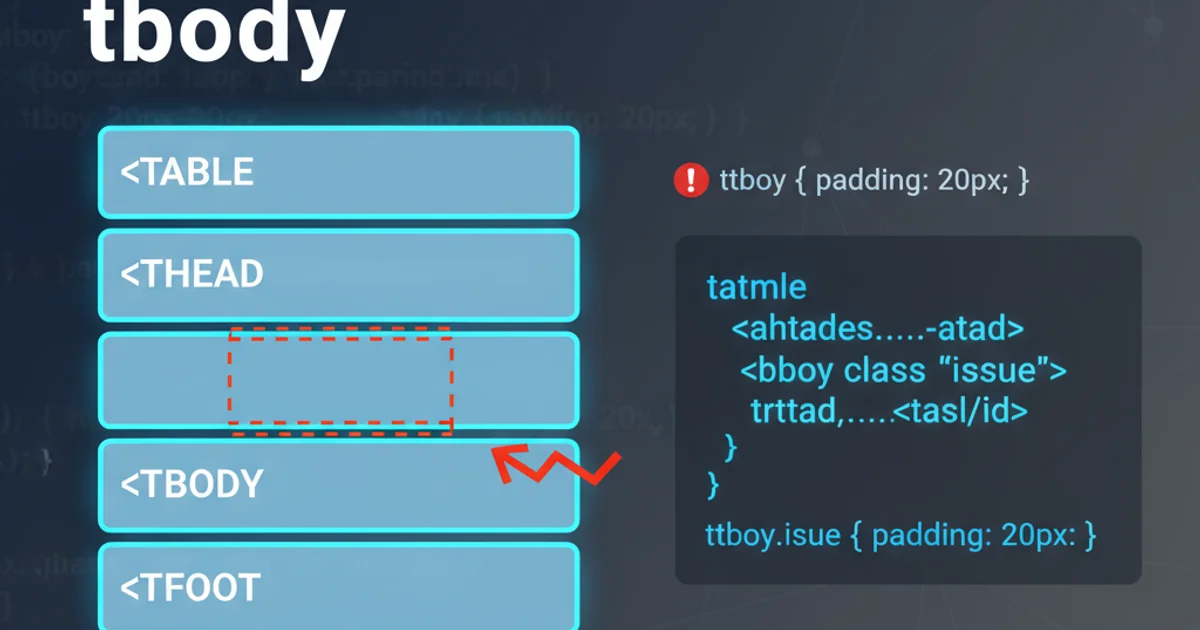Padding on tbody
Categories:
Understanding and Applying Padding to <tbody> Elements

Explore the challenges and solutions for applying padding directly to <tbody> elements in HTML tables, focusing on CSS techniques and common workarounds.
HTML tables are fundamental for displaying tabular data, but styling them can sometimes present unexpected challenges. One common hurdle developers encounter is the inability to directly apply padding to the <tbody> element using standard CSS. This article delves into why this limitation exists, how browsers interpret such styles, and provides practical workarounds to achieve the desired visual spacing within your table bodies.
The <tbody> Padding Conundrum
According to the CSS Box Model and the specifications for table rendering, padding and margin properties do not apply to table row group elements like <tbody> in the way they do to block-level elements. Browsers typically ignore padding declarations on <tbody> because its primary role is to group rows, not to act as a box with internal spacing. Instead, spacing within a table is usually controlled at the cell (<td> or <th>) level.
This behavior can be frustrating when you want to create visual separation between the table header (<thead>), body (<tbody>), and footer (<tfoot>) or between different logical sections within the table body itself. Directly applying padding-top or padding-bottom to <tbody> will often have no effect, leading to a search for alternative styling methods.
flowchart TD
A[Apply padding to tbody] --> B{Browser Renders?}
B -- No --> C[Padding Ignored]
B -- Yes (Rare/Non-Standard) --> D[Unexpected Behavior]
C --> E[Need Workaround]
E --> F[Apply padding to cells (td/th)]
E --> G[Use empty rows/cells for spacing]
E --> H[Apply border-spacing to table]
F --> I[Desired Visual Spacing Achieved]
G --> I
H --> IFlowchart illustrating the <tbody> padding problem and common workarounds.
Effective Workarounds for <tbody> Spacing
Since direct padding on <tbody> is not reliable, several techniques can be employed to achieve similar visual effects. The most common and recommended approach involves applying padding to the individual table cells (<td> or <th>) within the rows. This gives you granular control over the spacing.
Another method is to use empty rows or cells with a specific height or padding to create vertical gaps. For spacing between <thead>, <tbody>, and <tfoot>, you can also leverage CSS properties like border-spacing on the <table> element, or apply borders and margins to the <tr> or <td> elements strategically.
<table>
<thead>
<tr>
<th>Header 1</th>
<th>Header 2</th>
</tr>
</thead>
<tbody>
<tr>
<td>Data 1A</td>
<td>Data 1B</td>
</tr>
<tr>
<td>Data 2A</td>
<td>Data 2B</td>
</tr>
</tbody>
</table>
Basic HTML table structure.
/* This will likely be ignored by most browsers */
tbody {
padding-top: 20px; /* Ineffective */
padding-bottom: 20px; /* Ineffective */
}
/* Recommended workaround: Apply padding to cells */
tbody td,
tbody th {
padding: 10px 15px;
}
/* To create space between tbody and thead/tfoot */
/* Option 1: Use a dedicated spacing row */
.spacing-row td {
height: 20px; /* Or padding-top/bottom */
background-color: transparent;
border: none;
}
/* Option 2: Use border-spacing on the table (affects all cells) */
table {
border-collapse: separate;
border-spacing: 0 10px; /* Horizontal Vertical */
}
/* Option 3: Apply margin/border to first/last row/cell of tbody */
tbody tr:first-child td {
padding-top: 20px;
}
tbody tr:last-child td {
padding-bottom: 20px;
}
CSS examples demonstrating ineffective <tbody> padding and effective workarounds.
border-spacing on the <table> element, remember to set border-collapse: separate; as border-spacing has no effect when border-collapse is set to collapse.VBulletin Specific Considerations
While the core CSS principles apply universally, VBulletin forums (and similar CMS platforms) often inject their own CSS, which can sometimes override or interfere with custom styles. If you're working within a VBulletin environment, ensure your custom CSS is loaded after the default VBulletin stylesheets or use more specific selectors (e.g., !important if absolutely necessary, but generally avoid it) to ensure your styles take precedence.
Inspect the rendered HTML and computed styles using browser developer tools to understand how VBulletin's CSS might be affecting your table elements. Look for existing padding or margin rules on <td> or <th> elements that you might need to override.
!important can lead to CSS specificity wars and make your stylesheets difficult to maintain. Prefer using more specific selectors or ensuring your custom CSS loads last.